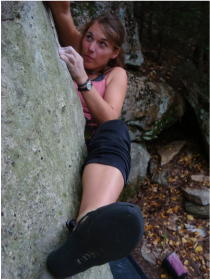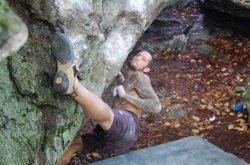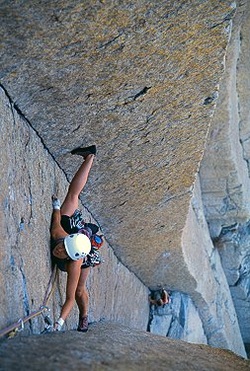 Rope, cord and webbing
Rope, cord and webbing
Climbing ropes are typically of kernmantle construction, consisting of a core of long twisted fibres and an outer sheath of woven coloured fibres. The core provides about 80% of the tensile strength, while the sheath is a durable layer that protects the core and gives the rope desirable handling characteristics.
Ropes used for climbing can be divided into two classes: dynamic ropes and low elongation ropes, sometimes called static ropes.
Dynamic Ropes.
Dynamic ropes are designed to absorb the energy of a falling climber, and are usually used as Belaying ropes. W
hen a climber falls, the rope stretches, reducing the maximum force experienced by the climber, their belayer, and equipment.
Static Ropes
Low elongation ropes stretch much less, and are usually used in anchoring systems. They are also used for abseiling (rappeling) and as fixed ropes climbed with ascenders.
Webbing
Modern webbing is often made from dyneema, which is usually stronger and lighter than nylon. While 12 mm dyneema slings have a tensile strength of around 22 kN, a one-inch (25-mm) tubular climb-spec nylon webbing has a tensile strength of about 20 kN (4000 pounds).[2] Some webbing is tubular or hollow core and is advantageous because rope can be placed inside of it, preventing damage to the sheath of a kernmantle rope if it hangs over a sharp edge. Webbing is inexpensive when compared with climbing rope.
When webbing is sewn together at the ends (using reinforced stitching), it becomes known as a sling or runner, and if you clip a carabiner to each end of the sling, you have a quickdraw. Webbing has many uses such as extending the distance between protection and a tie-in point, an anchor extension or equalization, securely anchoring a belayer (typically when the climber is heavier than the belayer), creating makeshift harnesses, carrying equipment, and as a component of quickdraws. Webbing is usually tied (using a water knot or beer knot).
Carabiner
Carabiners are metal loops w
ith spring-loaded gates (openings), used as connectors. Once made primarily from steel, almost all carabiners for recreational climbing are made from a light weight aluminum alloy. Steel carabiners are harder wearing, but much heavier and often used by instructors when working with groups.
Carabiners exist in various forms; the shape of the carabiner and the type of gate varies according to the use for which it is intended. There are two major varieties: locking and non-locking carabiners. Locking carabiners offer a method of preventing the gate from opening when in use. Locking carabiners are used for important connections, such as at the anchor point or a belay device. There are several different types of locking carabiners, including a twist-lock and a thread-lock. Non-locking carabiners are commonly found as a component of quickdraws.
Carabiners are made with many different types of gates including wire-gate, bent-gate, and straight-gate. The different gates have different strengths and uses. Most locking carabiners utilize a straight-gate. Bent-gate and wire-gate carabiners are usually found on the rope-end of quickdraws, as they facilitate easier rope clipping than straight-gate carabiners.
Carabiners are also known by many slang names including biner (pronounced beaner).
Quickdraws
Quickdraws (often referred to as "draws") are used by climbers to connect ropes to bolt anchors, or to other traditional protection, allowing the rope to move through the anchoring system with minimal friction. A quickdraw consists of two non-locking carabiners connected together by a short, pre-sewn loop of webbing. Alternatively, and quite regularly, the pre-sewn webbing is replaced by a sling of the above
-mentioned dyneema/nylon webbing. This is usually of a 60 cm loop and can be tripled over between the carabiners to form a 20 cm loop. Then when more length is needed the sling can be reverted back into a 60 cm loop offering more versatility than a pre-sewn loop. Carabiners used for clipping into the protection generally has a straight gate, decreasing the possibility of the carabiner accidentally unclipping from the protection. The carabiner into which the rope is clipped often has a bent gate, so that clipping the rope into this carabiner can be done quickly and easily.
Climbing harness
A harness is a system used for connecting the rope to the climber. Most harnesses used in climbing are preconstructed and are worn around the pelvis and hips, although other types are used occasionally.
Different types of climbing warrant particular features for harnesses. Sport climbers typically use minimalistic harnesses, some with sewn-on gear loops. Alpine climbers often choose lightweight harnesses, perhaps with detachable leg loops. Big Wall climbers
generally prefer padded waist belts and leg loops. There are also full body harnesses for children, whose pelvises may be too narrow to support a standard harness safely. These harnesses prevent children from falling even when inverted, and are either manufactured for children or constructed out of webbing. Some climbers use full body harnesses when there is a chance of inverting, or when carrying a heavy bag. There are also chest harnesses, which are used only in combination with a sit harness; this combination provides the same advantages as a full body harness. However, test results from UIAA show that chest harnesses can put more impact on the neck than sit harnesses, making them slightly more dangerous to use.
Apart from these harnesses, there are also caving and canyoning harnesses, which all serve different purposes. For example, a caving harness is made of tough waterproof and unpadded material, with dual attachment points. Releasing the maillon from these attachment points loosens the harness quickly.
Canyoning harnesses are somewhat like climbing harnesses, often without the padding, but with a seat protector, making it more comfortable to rappel. These usually have a single attachment point of Dyneema.
 Belay devices
Belay devices
Belay devices are mechanical friction brake devices used when belaying. They allow control of the belay rope while their main purpose is to allow locking off of the rope with minimal effort. Multiple kinds of belay devices exist, and some of which may additionally be used as descenders, for controlled descent on a rope, that is, abseiling or rappeling.
Belay devices include both passive and active belay devices. Passive belay devices rely on the brake hand and a carabiner to lock off the rope. Sticht plates and the Air Traffic Controller ATC are examples of passive belay devices.
Active belay devices have a built-in mechanism that locks off the rope without the help of any other pieces of equipment. A GriGri is an example. The offset cam in the GriGri locks off the rope automatically to catch a falling climber, much like a seatbelt in a car locks off to hold a passenger securely.
However, a GriGri, with its technology, often makes belayers become less vigilant. The GriGri is not a hands-free belay device. One mistake with the GriGri is reverse threading it. Reverse threading means to thread the GriGri the wrong way around, rendering the camming action useless. However, in a fall, with a reverse threaded GriGri, bending the rope sharply under the GriGri provides more than enough friction to hold a falling climber as long as the belay locks off the rope as they would with a tube style device.
An example of traditional belay is the Body Belay or the Hip Belay, where the rope is wrapped around the body to provide enough friction to catch a climber. This is often used in Alpine climbing where efficiency is important.
Sling
A sling or runner is an item of climbing equipment consisting of a tied or sewn loop of webbing that can be wrapped around sections of rock, hitched (tied) to other pieces of equipment or even tied directly to a tensioned line using a prusik knot, for anchor extension (to reduce rope drag and for other purposes), equalisation, or climbing the rope.
A daisy chain
A daisy chain is a strap, several feet long and typically constructed from one-inch tubular nylon webbing of the same type used in lengthening straps between anchor-points and the main rope. The webbing is bar-tacked (sewn) across at roughly two-inch intervals (or, in the past, tied) to create a length of small loops for attachment. Unlike the use of similar devices in backpacking, daisy chains in technical rock climbing are expected to be of sufficient strength to be "load bearing,". Daisy chain pockets however are not rated to full strength, but can only take static loads.
When clipped in, daisy chains should not be shortened by clipping in another pocket to the same karabiner. Failure of the pocket stitching results in the daisy chain disconnecting from the anchor, with potentially fatal consequences. If shortening the daisy chain when clipped in, in order to eliminate dangerous slack, a second karabiner should be used to connect to the anchor.
Though daisy chains are sometimes used by free climbers as a type of sling (a quick attachment used from harness directly to a belay anchor), and for ad hoc purposes similar to those of the backpacker, the canonic use for a daisy chain is in aid climbing, wherein the leader will typically attach one end to the harness, and the other to the top-most anchor placement (by carabiner or fifi hook), particularly after having ascended in étriers as high as possible. This allows the leader to hang from the daisy chain while preparing the next anchor placement. The closely spaced loops allow fine-tuning the length from harness to anchor, thereby allowing the best possible reach for the next placement.
Daisy chains should not be confused with étriers, also known as aiders, which are short ladders made in the same way, but with larger loops, also used in aid climbing, nor with load-limiting devices often known as screamers (from their first trade name) designed to simulate a dynamic belay
In the early days of climbing, many would have considered specialised clothing to be cheating. In fact, the first climbers considered an untucked shirt or unbuttoned sport jacket a sign of weakness. Several climbers even chose to climb bare foot, an act that modern climbers would find amazing. In the 80s and early 90s, the trend was to wear tight, brightly-colored clothes. The trend, now, is to wear looser fitting clothing.
Helmet
A Petzl Elios climbing helmet designed for caving and mountaineering
The climbing helmet is a piece of safety equipment that primarily protects the skull against falling debris (such as rocks or dropped pieces of protection) and impact forces during a fall. For example, if a lead climber allows the rope to wrap behind an ankle, a fall can flip the climber over and consequently impact the back of the head. Furthermore, any effects of pendulum from a fall that have not been compensated for by the belayer may also result in head injury to the climber. The risk of head injury to a falling climber can be further significantly mitigated by falling correctly.
Climbers may decide whether to wear a helmet based on a number of factors such as the type of climb being attempted, concerns about weight, reductions in agility, added encumbrances, or simple vanity. Additionally, there is less incentive to wear a helmet in artificial climbing environments like indoor climbing walls (where routes and holds are regularly maintained) than on natural multi-pitch routes or ice climbing routes (where falling rocks and/or ice are likely).
Climbing shoes
Specifically designed foot wear is usually worn for climbing. To increase the grip of the foot on a climbing wall or rock face due to friction, the shoe is covered with a vulcanized rubber layer. Usually, shoes are only a few millimetres thick and fit very snuggly around the foot. Stiffer shoes are used for "edging", more compliant ones for "smearing". Some have foam padding on the heel to make descents and rappels more comfortable. Climbing shoes can be re-soled which decreases the cost and environmental impact of purchasing new shoes.
Belay gloves
Belay gloves have been shunned by climbers who claim that gloves reduce grip on and control over the rope. For other climbers, belay gloves are a useful aid for belaying on long climbs. In particular, when lowering a climber they remove the possibility of rope burn and the subsequent involuntary release of the rope.
Belay gloves are constructed from either leather or a synthetic substitute. They typically have heat resistant padding on the palm and fingers.
It is very important to use gloves if using a classic or body belay. They are also very useful for belaying with single lead ropes that are 9.5mm or smaller.[5]








